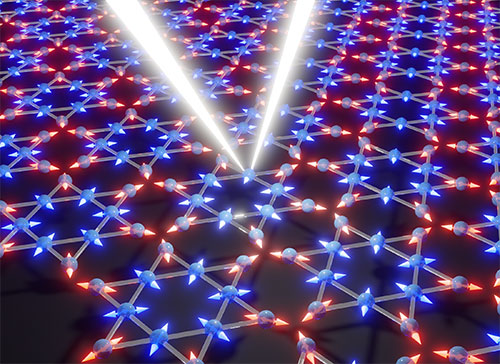New Insights into Kagome Superconductors
Scientists found an unconventional charge density wave within a Kagome superconductor
December 31, 2021
 enlarge
enlarge
In the Kagome lattice of (Cs,Rb)V3Sb5, blue and red arrows indicate motion of vanadium towards and away from the hexagon center upon formation of the CDW as observed by x-ray diffraction. The associated electronic band topology was observed by ARPES. Image credit: Phys. Rev. X 11 (3), ID(031050) (2021)
The Science
Scientists revealed that the topological band structure in a Kagome superconductor can host an unconventional charge density wave.
The Impact
This unconventional charge density wave (CDW) constitutes an emerging intertwined state that could provide a pathway towards using topological superconductivity for quantum computing.
Summary
Emergent phenomena in new materials offer a pathway to a new generation of technology based on quantum materials. However, to create new quantum computers, researchers need to understand the complex interplay among competing interactions of the material’s fundamental properties such as charge, spin, and others.
In this study, a team of researchers investigated a new quantum material that falls into the category of Kagome superconductors. Superconductors are materials that lose their electrical resistance when cooled to extremely low temperatures. The special feature of Kagome superconductors is their specific arrangement of atoms that resembles a Japanese basket weaving pattern called a Kagome weave.
The team of researchers found that their Kagome superconductor, (Cs, Rb)V3Sb5, has an unconventional charge density wave (CDW). This correlated pattern constitutes an emerging intertwined state.
The team used angle-resolved photoemission spectroscopy (ARPES) at the Electron Spectro-Microscopy (ESM) beamline to unveil a local plateau in the CDW induced by quantum interferences in the band structure of the material. They also performed x-ray diffraction studies at the Integrated In situ and Resonant Hard X-ray Studies (ISR) beamline to reveal the superstructure formation caused by the bulk CDW in the material. Both the ESM and ISR beamlines are part of a suite of advanced research tools to investigate novel materials at National Synchrotron Light Source II (NSLS-II). To further advance their studies, the team also did x-ray scattering measurements at the Advanced Photon Source (APS). NSLS-II and APS are U.S. Department of Energy Office of Science User Facilities located at DOE’s Brookhaven National Laboratory and DOE’s Argonne National Laboratory, respectively.
The team used Raman spectroscopy studies to reveal how the continuum sharpens into a peak upon cooling towards the CDW. The comprehensive understanding of this novel material obtained from these complementary studies could provide a pathway towards using topological superconductivity for quantum computing.
Download the research summary slide
Contact
H. C. Lei
Renmin University of China
hlei@ruc.edu.cn
H. Miao
Oak Ridge National Laboratory
miaoh@ornl.gov
Publications
H. Li, T. T. Zhang, T. Yilmaz, Y. Y. Pai, C. E. Marvinney, A. Said, Q. W. Yin, C. S. Gong, Z. J. Tu, E. Vescovo, C. S. Nelson, R. G. Moore, S. Murakami, H. C. Lei, H. N. Lee, B. J. Lawrie, and H. Miao, Observation of unconventional charge density wave without acoustic phonon anomaly in kagome superconductors AV3Sb5 (A=Rb,Cs), Phys. Rev. X 11 (3), ID(031050) (2021); DOI: 10.1103/PhysRevX.11.031050
Funding
This research was sponsored by the U.S. Department of Energy, Office of Science, Basic Energy Sciences, Materials Sciences and Engineering Division (IXS, XRD, ARPES data analysis, Raman spectroscopy) and by the Laboratory Directed Research and Development Program of Oak Ridge National Laboratory, managed by UT-Battelle, LLC, for the U. S. Department of Energy (IXS and ARPES experiment). This research used resources (IXS experiment at beamline 30ID) of the Advanced Photon Source, a U.S. DOE Office of Science User Facility operated for the DOE Office of Science by Argonne National Laboratory under Contract No. DE-AC02-06CH11357. Hard x-ray diffraction and ARPES measurements used resources at 4-ID and 21-ID-1 beamlines of the National Synchrotron Light Source II, a US Department of Energy Office of Science User Facility operated for the DOE Office of Science by Brookhaven National Laboratory under contract no. DE-SC0012704. Extraordinary facility operations were supported in part by the DOE Office of Science through the National Virtual Biotechnology Laboratory, a consortium of DOE national laboratories focused on the response to COVID-19, with funding provided by the Coronavirus CARES Act. Raman spectroscopy was conducted at the Center for Nanophase Materials Sciences, which is a DOE Office of Science User Facility.
2021-19510 | INT/EXT | Newsroom









